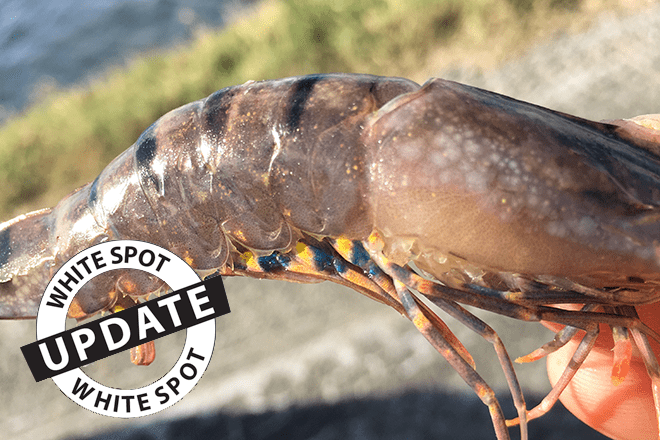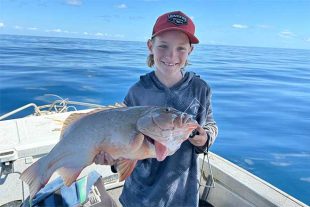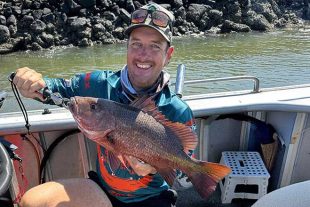THE latest round of surveillance results for white spot disease have now been finalised, with the results showing no further spread, which is welcome news for the Queensland seafood industry.
More than 60 sites across the state were tested for the virus that causes white spot disease and the findings have shown there is no indication the virus is spreading. In April, testing revealed nine sites in Moreton Bay near Deception Bay and Redcliffe returned positive results for the virus. Minister for Agricultural Industry Development and Fisheries Mark Furner said those detections were in the same area that positive results were found in 2017.
“Given that no new detections of the virus have been found in the Moreton Bay area means we’ve done a great job of containing the virus and not letting it spread,” Mr Furner said. “Furthermore, all samples collected along the east coast of Queensland, outside the white spot disease movement restriction area, have returned negative results for the virus, which is great news. To continue to contain the virus in the Moreton Bay area, it is important for movement restrictions to remain in place for prawns, yabbies and marine worms from Caloundra to the NSW border and west to Ipswich.”
Acting Chief Biosecurity Officer Malcolm Letts said it is still unclear whether white spot disease will be considered established in Moreton Bay, however for the time being nothing will change. “All states and territories in Australia are currently undergoing proof of freedom surveillance for the virus that causes white spot disease, therefore no decision will be made until all the results have been finalised,” Mr Letts said. “Commercial fishers and prawn farmers will need to remain vigilant if operating in the movement restriction area.”
Map of the surveillance results
Prawn and crab samples were collected from 54 sites in the Moreton Bay area to test for the virus that causes white spot disease. Nine sites returned positive results in the northern part near Deception Bay and Redcliffe Peninsula. The surveillance results and a map of the surveillance area are available on the DAF website.
Along the east coast of Queensland samples were collected from 10 sites from Caloundra through to Cairns, the surveillance results and a map of the surveillance sites are also available on the DAF website.
If viewing the maps from a desktop computer, click on each surveillance site (green or red dot) and more information such as sample numbers and species will appear in a panel on the left hand side of the screen.
If viewing the maps from a mobile phone, click on each surveillance site (green or red dot) then click on the sample name, which will appear at the bottom of the screen, to view further surveillance information.
Industry support projects
To further support those who are impacted by trade restrictions, due to white spot disease, Biosecurity Queensland have a number of projects in motion, such as research into treatment options for raw prawns through gamma irradiation.
The research will determine the minimal effective dose of gamma irradiation needed to render white spot syndrome virus (WSSV) non-infectious in prawns. A reduction in treatment dose, if successful, would provide a viable option for industry to continue trade of uncooked prawns sourced from the movement restriction area.
We will also continue to work with marine worm harvesters to determine whether there are possible avenues to help reduce trade restrictions currently placed on them.
Earlier this year, the Queensland Government launched the 2018 Queensland Seafood campaign featuring footy legend Sam Thaiday to show our support for the industry and to encourage people to ask for Queensland seafood when they go shopping.
The campaign was a great success with the launch being picked up by all the major television news stations just before Easter. Overall, the advert reached 834,416 people across Queensland and promotional material (posters, sticker packs, counter cards) was displayed in 110 seafood retail outlets in South East Queensland, urging customers to ‘Ask for Queensland Seafood’ over the Easter season.
Later this year we will launch another campaign to further bolster this message and ensure Queenslanders continue to buy local seafood and support their local seafood industry.
White spot disease surveillance FAQs
Do these results mean that white spot disease is here to stay?
All states and territories in Australia are currently undergoing proof of freedom surveillance for the virus that causes white spot disease. No decision will be made about whether the disease will be considered established in Moreton Bay or not until all those results have been finalised.
Have movement restrictions changed?
No. Movement restrictions remain unchanged across Moreton Bay which means raw prawns, yabbies and marine worms cannot be moved out of the area, unless cooked first.
Can white spot disease be eradicated?
White spot disease is an extremely contagious viral disease that is present in many areas of the world. Once it has been established in a wild crustacean population it has not been known to be eradicated. At this stage, we don’t know if the virus that causes white spot disease has established in wild crustaceans in Moreton Bay. It is important that we complete testing in all states and territories before making any decisions on the future of our white spot disease strategy.
What will this mean for buying and selling seafood in Queensland?
The trade of seafood in Queensland will continue in accordance with the requirements of the current movement restrictions for white spot disease carriers. That means raw prawns, yabbies and marine worms cannot be moved out of the movement restriction area, unless cooked first.
Why are imported green prawns still allowed in the country?
The Queensland Government doesn’t control the importation of produce into the country – this is controlled by the Australian Government. A new import risk assessment for raw prawns is being conducted by the Federal Government. The Queensland Government has provided input into the process through a formal written submission advocating for the implementation of stronger measures to reduce future risks associated with imported seafood that may contain diseases of concern to Australia.
When will the next round of surveillance be carried out?
The next round of surveillance in the white spot disease movement restriction area and along the east coast of Queensland is scheduled to commence in August 2018 and June 2019 respectively. Surveillance sampling is expected to run for approximately three months.
What does white spot disease surveillance actually mean?
Surveillance means we are looking for white spot disease or signs of the disease. When conducting surveillance we collect prawn samples from different locations across a specific area and test them in our laboratory to see if they have the virus that causes white spot disease.
What is actually done when you test a prawn sample?
Our technicians at Queensland’s Biosecurity Sciences Laboratory take part of the prawn and break it up in a small tube. The pulverised sample is used to obtain DNA through a process called DNA extraction. The DNA undergoes a diagnostic process (real time Polymerase Chain Reaction (PCR)) that makes billions of copies of the DNA, and using a fluorescence marker, highlights if DNA from the virus that causes white spot disease is present. This test is similar to tests used by forensic scientists when testing for human DNA at a crime scene.
All positive tests are sent to the Australian Animal Health Laboratory in Geelong, for confirmation where the samples are tested again.
What is proof of freedom surveillance?
Proof of freedom is a nationally coordinated and structured approach to surveillance through sampling, to determine national freedom from, in this case, white spot disease (WSD). The international standard requires two years of consecutive negative results for WSD, from the samples obtained during active surveillance to demonstrate freedom from disease.
Reporting white spot disease
Prawns with white spot disease may have a loose shell with numerous white spots (0.5–2.0 mm in diameter) on the inside surface of the shell and a pink to red discolouration.
Suspected cases of white spot disease must be reported to Biosecurity Queensland immediately through the online white spot disease reporting form or by calling 13 25 23. Take note of the location and time and if possible, freeze a sample of the suspect animals for later testing.
 Bush ‘n Beach Fishing Magazine Location reports & tips for fishing, boating, camping, kayaking, 4WDing in Queensland and Northern NSW
Bush ‘n Beach Fishing Magazine Location reports & tips for fishing, boating, camping, kayaking, 4WDing in Queensland and Northern NSW









